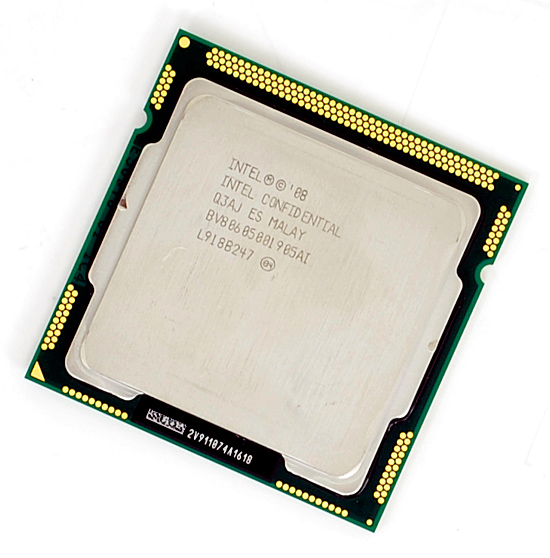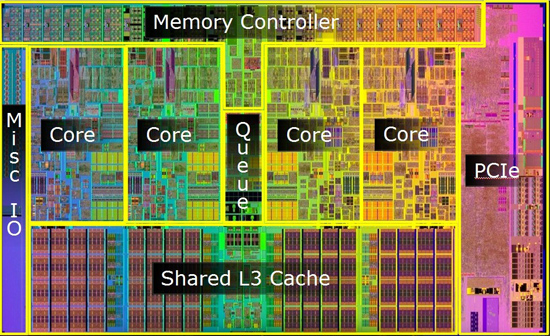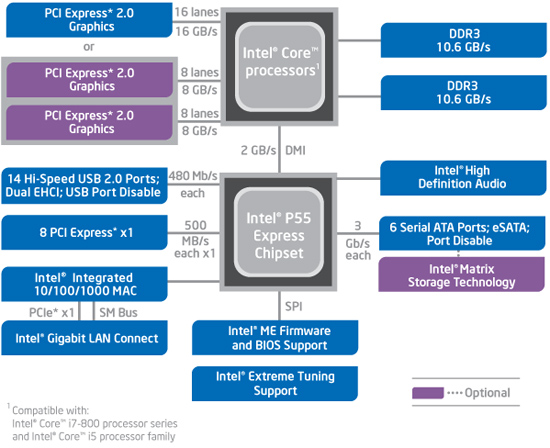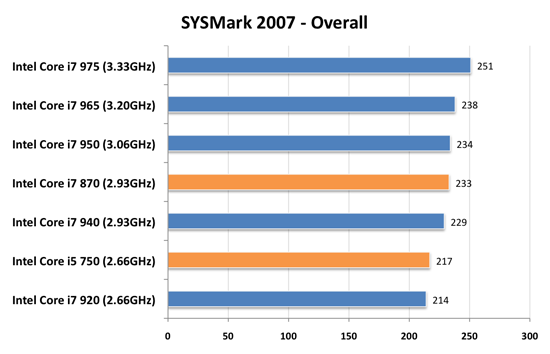Intel's Core i7 870 & i5 750, Lynnfield: Harder, Better, Faster Stronger
by Anand Lal Shimpi on September 8, 2009 12:00 AM EST- Posted in
- CPUs
Intel is on the verge of transitioning to 32nm. We'll see the first parts this year. What do you do with your 45nm fabs when you start moving volume away from them? Make really cheap quad-core Nehalems of course:

I'm talking $196. I'm talking faster than AMD's entire lineup. I'm talking about arguably the best processor of 2009. I'm talking about Lynnfield, and here's its backside:

Mmm
I spent much of the past year harping on AMD selling Nehalem-sized Phenom IIs for less than Intel sold Nehalems. With Lynnfield, Intel actually made Nehalem even bigger all while driving prices down. Like I said, what do you do when you're still making boatloads of money in a recession and are about to start emptying your 45nm fabs?
I should clear things up before we progress much further. Lynnfield is the codename for mainstream 45nm quad-core Nehalem, while Bloomfield refers to the first Nehalem launched at the end of 2008:
| Processor | Manufacturing Process | Die Size | Transistor Count | Socket |
| Bloomfield | 45nm | 263 mm2 | 731M | LGA-1366 |
| Lynnfield | 45nm | 296 mm2 | 774M | LGA-1156 |
Despite being cheaper, Lynnfield is larger than Bloomfield. The larger die is due to one major addition: an on-die PCIe controller.

Bloomfield, The First Nehalem, circa 2008

Lynnfield, Nehalem for All, circa 2009
The pink block to the right of the die is the PCIe controller, that's 16 PCIe 2.0 lanes coming right off the chip. Say hello to ultra low latency GPU communication. You'd think that Intel was about to enter the graphics market or something with a design like this.
Sacrifices were made to reduce CPU, socket and board complexity. Gone are the two QPI links that each provided 25.6GB/s of bandwidth to other CPUs or chips on the motherboard. We also lose one of the three 64-bit DDR3 memory channels, Lynnfield only has two like a normal processor (silly overachieving Bloomfield).

Intel's Bloomfield Platform (X58 + LGA-1366)
The sum is that Lynnfield is exclusively single-socket; there will be no LGA-1156 Skulltrail. While the dual-channel memory controller isn't really a limitation for quad-core parts, six and eight core designs may be better suited for LGA-1366.

Intel's Lynnfield Platform (P55 + LGA-1156)
The loss of QPI means that Lynnfield doesn't have a super fast connection to the rest of the system, but with an on-die PCIe controller it doesn't matter: the GPU is fed right off the CPU.
The Lineup
We get three Lynnfield CPUs today: the Core i7 870, Core i7 860 and the Core i5 750. Intel's branding folks told us that the naming would make sense one we saw the rest of the "Core" parts introduced; yeah that was pretty much a lie. At least there aren't any overlapping part numbers (e.g. Core i5 860 and Core i7 860).
The i7 in this case denotes four cores + Hyper Threading, the i5 means four cores but no Hyper Threading. The rules get more complicated as you bring notebooks into the fray but let's momentarily bask in marginal simplicity.
| Processor | Clock Speed | Cores / Threads | Maximum Single Core Turbo Frequency | TDP | Price |
| Intel Core i7-975 Extreme | 3.33GHz | 4 / 8 | 3.60GHz | 130W | $999 |
| Intel Core i7 965 Extreme | 3.20GHz | 4 / 8 | 3.46GHz | 130W | $999 |
| Intel Core i7 940 | 2.93GHz | 4 / 8 | 3.20GHz | 130W | $562 |
| Intel Core i7 920 | 2.66GHz | 4 / 8 | 2.93GHz | 130W | $284 |
| Intel Core i7 870 | 2.93GHz | 4 / 8 | 3.60GHz | 95W | $562 |
| Intel Core i7 860 | 2.80GHz | 4 / 8 | 3.46GHz | 95W | $284 |
| Intel Core i5 750 | 2.66GHz | 4 / 4 | 3.20GHz | 95W | $196 |
Keeping Hyper Threading off of the Core i5 is purely done to limit performance. There aren't any yield reasons why HT couldn't be enabled.
Intel was very careful with both pricing and performance of its Lynnfield processors. I'm going to go ahead and say it right now, there's no need for any LGA-1366 processors slower than a Core i7 965:

This is only one benchmark, but it's representative of what you're about to see. The Core i7 870 (LGA-1156) is as fast, if not faster, than every single LGA-1366 processor except for the ones that cost $999. Its pricing is competitive as well:

For $196 you're getting a processor that's faster than the Core i7 920. I'm not taking into account motherboard prices either, which are anywhere from $50 - $100 cheaper for LGA-1156 boards. I don't believe LGA-1366 is dead, but there's absolutely no reason to buy anything slower than a 965 if you're going that route.










343 Comments
View All Comments
jasperjones - Tuesday, September 8, 2009 - link
Wonderful article as usual on AT. Read the articles on the website of your main competitor minutes before and didn't learn nearly as much about the LGA 1156 platform as I did here. Well done!I have one somewhat cheap comment. I always feel there's only one thing I do for which I really "need" my Core i7. And that's test-driving and debugging my well-threaded code (which makes use of OpenMP, MPI, threaded Intel MKL, etc.) before scp-ing it over to a cluster. Obviously, when testing code, I run using 8 threads. Still think that the Core i7 is probably more competitive in that area (performance/$ wise) than in the ones which this review focuses on (simply because I assume such code puts enough stress on the processors such that turbo-boosting is out of the question). On the other hand, I don't really care if gzip takes 2.5 or 3 seconds to compress a file (or if flac takes 8 or 9 seconds to encode my wav).
As I said, it's a cheap point. Just saying that I feel I primarily need "oomph" when running well-threaded stuff. Again, great article!
AeroWB - Tuesday, September 8, 2009 - link
Thanks for the interesting read, I do agree with some other people that some things are missing (clock for clock comparison) and some things are weird (core i7 with 1066DDR3). Some people are saying that everyone is overclocking their core i7, and while most readers of this article will probably be geeks that overclock I also read these articles as a systembuilder and I know that at least 95% of my customers don't overclock, so I really dig non-overclocked comparisons and results.There is also one thing I do not agree on, lets have another look at the page "The Best Gaming CPU?" and look to the DoWII results. What I see there is totally different from your conlusion though you do mention it in the text, the Bloomfield has lower minimum framerate then Lynnfield, but still your conclusion is Bloomfield is better then Lnynfield and Lynnfield is better then the Core2E8600. Ehm ???
Lets be clear the core i7 920 really sucks here as of its really low minimum fps you will have stutters. Great gaming is all about having a butter smooth FPS which dependent on the game type needs to be between 30 and 60 FPS. Basically the best game experience here will probably be with the E8600 as it has the highest minimum at 33 FPS which is great for RTS gaming. In order to say which CPU is best you should have an extra statistic like how much and how long the framerate dropped below 30FPS or something but as we do not have this data the minimum framerate is our next best thing. As weve seen before the Core i7 is good when using SLI/Crossfire but on par with the core2 when using a single GPU. Intel also told us themselfs that Core i7 was not made for gaming but for taking a bigger part in the server market. When increasing resolution/quality of gaming when using one GPU the Phenom 2 was often as fast and sometimes even faster then the Core i7. Unfortunately most CPU comparison with gaming are done at low to medium resolutions and quality so this effect couldn't be seen in most tests, but there were very few where this could be seen. So gaming with Core i7 920 only made sense when using SLI/Crossfire (as it scaled much better with these then Phenom2) or when paying the extra money (over Phenom2) because you used the system mostly for other task like video editing or so.
Now we can see this gaming problem of the Core i7 has been (at least partly) solved with Lynnfield, but still the Phenom2 965 has a higher minimum then the Core i5 750 so I would still prefer that one.
The other gaming test are not really relevant as all cpu's score a minimum of 60 FPS (ok one exception on 59) and so you won't notice any difference between all of the tested CPU's with those settings.
Still it is probable that the better gaming CPU in these test will also be better with higher settings, but as I have seen with the weird Core i7 / Phenom2 results I want to see tests with higher settings or test with more demanding games. And we want minimum and average results to determine which is best.
Sorry for the long post
iwodo - Tuesday, September 8, 2009 - link
I am waiting for SandyBridge or even Ivy Bridge for FMA.For now, a C2Q two years ago with money spent on graphics card will do fine.
The whole LGA socket and naming is a complete mess.
Dont get me wrong, it is a good Processors, but not the jump from Pentium 4 to C2D.
Money spend on SSD and Graphics is much better valued.
JonnyDough - Tuesday, September 8, 2009 - link
My dual core Opty 185 is still doing fine...Fallout 3 is still playable with my 8800GTS 640. The system has a slight OC and is chugging along at a minimum of 45FPS in the game on decent settings. Granted, it can't play every game - but I can only play one at a time anyway, and my life does not revolve around gaming. Hello...BEER PONG!Griswold - Tuesday, September 8, 2009 - link
I agree. I'll get excited when the 32nm dual cores with HT arrive. That would be a worthwhile "upgrade" (but a downgrade in number of cores, simply because I dont need 4 physical cores that much anymore) from my q6600 on a p35.Still, its a good product, just not worth an upgrade for everyone.
strikeback03 - Tuesday, September 8, 2009 - link
I was hoping there would be 32nm quads in this cycle, but it appears not. I'd definitely like something faster than my E6600/P965, but don't think it is worthwhile in time or money to just go to a C2Q.R3MF - Tuesday, September 8, 2009 - link
I spent much of the past year harping on AMD selling Nehalem-sized Phenom IIs for less than Intel sold Nehalems. With Lynnfield, Intel actually made Nehalem even >>>bigger<<< all while driving prices down.i think you mean smaller.
strikeback03 - Tuesday, September 8, 2009 - link
Nope, he meant bigger. Same process + more transistors = larger die, as is illustrated in the table.JonnyDough - Tuesday, September 8, 2009 - link
I think AMD realized years ago that they had awoken a sleeping giant, and it was a smart move to start thinking about competing graphically when they did. They saw how IBM had to change when Intel reared its ugly head. If you put all your eggs in one basket, you'll surely drop your next meal at some point. Diversifying into new markets was a smart move. Anyone who said that AMD didn't have good leadership didn't know what they were saying. Sure, money got really tight - but that's what has to happen to someone in a very competitive market at some point. Just take a look at GM. Giants crumble, little guys take over, and giants can muster a comeback...blyndy - Tuesday, September 8, 2009 - link
"I think AMD realised years ago that they had awoken a sleeping giant, and it was a smart move to start thinking about competing graphically when they did."That's an interesting thought.
I think there were to mains reasons why AMD acquired ATI.
1) in response to the news of Larrabee -- pre-emptive defensive move.
2)To diversify in preparation for Intels technological onslaught to finally kill its only CPU competitor.
So it may have been a smart move. On the other hand, knowing how patent riddled the CPU business is, maybe they could have ramped up R&D, but AMD is puny next to Intel.